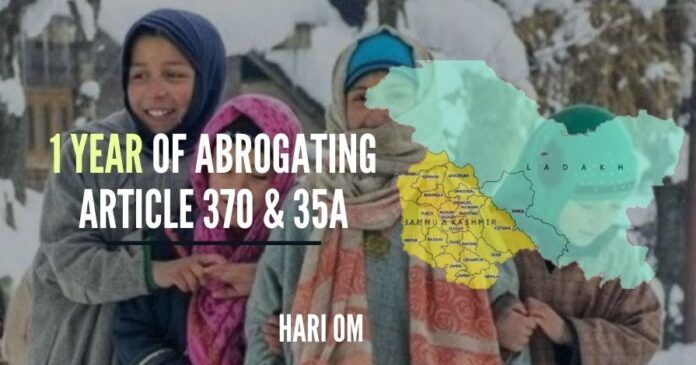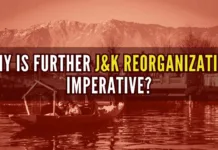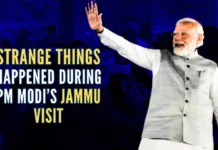
J&K and Ladakh have been integrated fully into India
UT of J&K and Ladakh turned one year old on October 31. However, the Act to this effect was adopted by Parliament on August 5-6, 2019. That day, the Narendra Modi Government also scrapped the 69-year-old J&K’s separate status by reading down Article 370 and scrapping Article 35A. The main objectives behind these historic changes were four:
- To fully integrate the sensitive border region bordering China and Pakistan into India and accelerate developmental processes in the region.
- To tackle the menaces of terrorism and separatism in Kashmir in a more effective manner.
- To meet the 70-year-old demand in Ladakh seeking separation from Kashmir and Central rule in the Trans-Himalayan region.
- To dispense justice to the grossly discriminated against people of Jammu province.
The people in Ladakh, cutting across party lines, are urging the Centre to bring the region under the ambit of the Sixth Schedule of the Indian Constitution so that the land and jobs become the sole preserve of the local population.
It’s time to examine if the Union Government has achieved the desired results and to what extent. Indeed, J&K and Ladakh have been integrated fully into India. J&K has been brought under the ambit of all the over 800 Central laws. Almost all the archaic and out-dated laws of the erstwhile J&K State, including the discriminatory State Subject laws, have either been repealed or amended. New domicile rules have been enforced. The process of total integration of J&K into India completed on October 26, 2020, when the new land laws were introduced. The laws declared all Indians eligible for buying land, barring agriculture land, in J&K. The choice of the date was very meaningful. It was on this day in 1947 that J&K acceded to India. This is one aspect of the issue under scrutiny. It’s very inspiring. The people of Jammu province, including West Pakistan refugees, Gorkhas and Valmikis, and many sections in Kashmir, including internally-displaced Kashmiri Hindus, have all welcomed these changes and accepted them cheerfully. Not just this. Developmental processes also have been accelerated to a considerable extent.
The other issue under scrutiny is the developments in Ladakh post-Article 370 abrogation and reorganization of the erstwhile J&K State. The people there, barring a few disgruntled elements in the Shia-majority Kargil district, are still in a celebration mode. They are continuing to celebrate October 31 as a day of deliverance and thanksgiving. Why not? After all, the Narendra Modi Government fulfilled their age-old demand seeking UT status for the region. That the people of Leh district again voted overwhelmingly for the BJP in the just-held Leh Hill Council Development polls only established that. At the same time, however, the people in Ladakh, cutting across party lines, are urging the Centre to bring the region under the ambit of the Sixth Schedule of the Indian Constitution so that the land and jobs become the sole preserve of the local population. It’s a debatable issue. It’s hoped that the issue would be resolved sooner than later by the Centre taking into consideration the interests of the local population and the larger national interest. Ladakh is not a normal UT. It’s highly strategic and vital for national security.
The things in Jammu province, unlike Ladakh, are somewhat different, although the people there welcomed, and continue to welcome, their integration into the national mainstream. The reasons are not far to seek. The most notable one is that the state apparatus continues to be Kashmir-centric as the administrative structure remained almost unchanged even after the abolition of the J&K’s separate status. It’s true that the bulk of top bureaucrats in the Civil Secretariat and the Secretariat of Lt Governor are from other parts of the country. But it’s also true that they have failed to address the issues facing Jammu. The valley-centric elements in the finance, planning, home, revenue, tourism, agriculture, and forest departments; recruitment agencies; financial institutions; and nation-building departments such as education continue to play the shots as before. No wonder then that a streak of discontent, disappointment, and dissatisfaction has gripped all in Jammu province, barring those few close to the corridors of power.
A reference here to just one instance of gross discrimination with Jammu would be in order. The Department of Fire and Emergency Services (F&ES) released a selection list of 98 drivers and 592 firemen on October 03. No less than 453 positions went to Kashmir. As for Jammu province, it got only 231. The result: Many protests took place in Jammu but no impact whatever. The truth is that many political and social groups have been striving to form a front calculated to making New Delhi treat Jammu like Ladakh and grant this region full state status. The Government of India has to address the Jammu issue and there is but one way in which it can be addressed and that is by giving it a political instrument – Statehood status or regional council invested with full legislative, executive, and financial powers – that empowers the people of Jammu to manage their own socio-economic and politico-administrative affairs themselves.
The whole point is that New Delhi still has to surmount many problems. It has to tackle the irresponsible and questionable Gupkaris to eradicate fissiparous tendencies in Kashmir and it has to implement the new land laws in letter and spirit at any cost.
However, it’s Kashmir which continues to pose a live threat to the unity and integrity of India. Eight Kashmir parties, which remained dormant and devoid of political life and activity for more than 12 months, have become very active. Some of them include Farooq Abdullah’s National Conference (NC) and Mehbooba Mufti’s Peoples Democratic Party (PDP). They have launched the People’s Alliance for Gupkar Declaration (PAGD) under the leadership of former J&K CM Farooq Abdullah. Its immediate objective is the restoration of the pre-2019 status – Article 370, Article 35A, J&K Constitution, and J&K flag. Farooq Abdullah has stated that Kashmiris would prefer Chinese rule and that the Chinese support could restore Article 370 in J&K. His Gupkar group has also made it loud and clear that peace would return to Kashmir only after the Kashmir issue was resolved.
It needs to be underlined that these Gupkaris have found in the new land laws a God-sent opportunity to arouse popular passions in Kashmir and in the non-Hindu and non-Buddhist-majority areas in Jammu and Ladakh. They have unleashed a no-holds-barred misinformation campaign against the land laws. They are frightening their co-religionists by telling them that New Delhi has planned to change Kashmir’s demography, erode the Kashmiris’ identity, and loot and plunder the state’s natural resources. They are making inflammatory statements and the fallout is a spurt in terror-related attacks on soft targets. Sadly, some fringe elements in Jammu have also advertently or inadvertently walked into the Gupkaris’ trap. They too are opposing the new land laws without realizing the dangerous ramifications of what they are doing.
The whole point is that New Delhi still has to surmount many problems. It has to tackle the irresponsible and questionable Gupkaris to eradicate fissiparous tendencies in Kashmir and it has to implement the new land laws in letter and spirit at any cost. No going back. To go back would be only to embolden the Gupkaris. India has to behave as genuine states behave. Similarly, the Narendra Modi Government has to conciliate the discriminated against people of Jammu province, the most stable and tested pro-India constituency. There is no other alternative. Lastly, it has to find a rational and national solution to the demand in Ladakh seeking a dispensation under the Sixth Schedule of the Indian Constitution.
Note:
1. The views expressed here are those of the author and do not necessarily represent or reflect the views of PGurus.
- ‘Kashmir My core constituency’: Revisiting July 12, 2003 to understand politics, Omar Abdullah-style - March 15, 2024
- Total deviation from traditional approach: Seven takeaways from PM Modi’s March 7 Srinagar visit - March 9, 2024
- Status of political parties: Why is further J&K reorganization imperative? - March 1, 2024











Hi Guys, something is brewing within the ‘community’.
In the past few hours we had an
1. attack in Austria,
2. Hindu homes destroyed in Bangladesh, 3. UP namaz at temple.
[…] To Read More, Please Visit Source […]